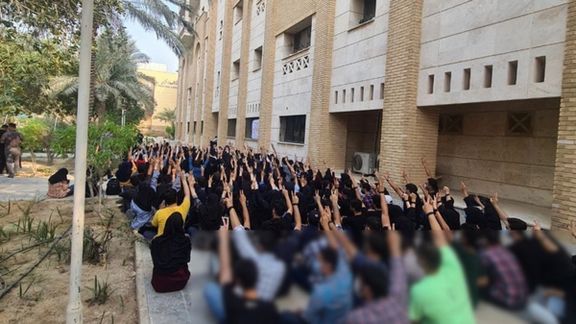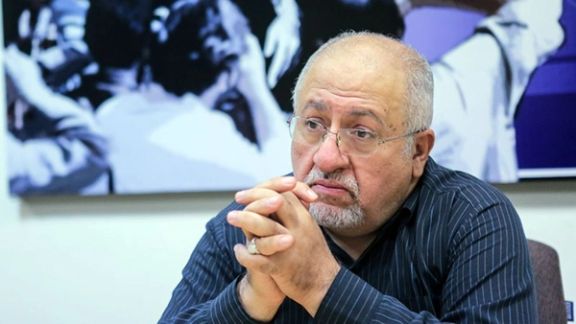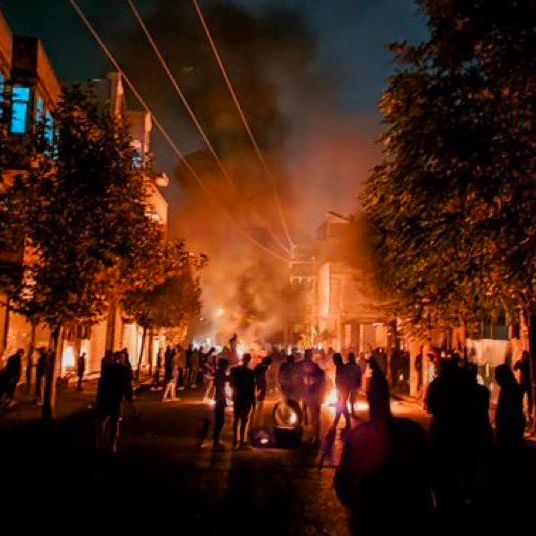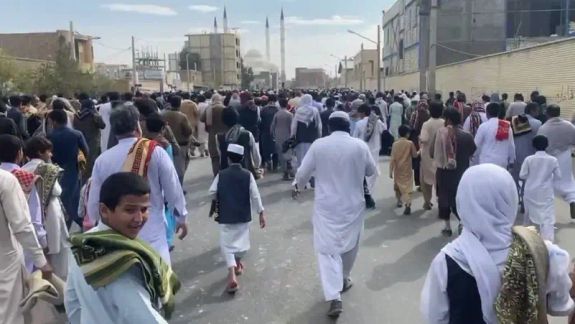Students Keep Boycotting Classes Amid Iran’s Mounting Crackdown

As the Islamic Republic continues expulsion and suspensions, students are boycotting classes and holding sit-ins in various universities across the country.

As the Islamic Republic continues expulsion and suspensions, students are boycotting classes and holding sit-ins in various universities across the country.
The Telegram channel of Student Councils Union announced that students at Bojnord University of Medical Sciences staged a sit-in Thursday to protest the illegal suspension of their peers and threats by the authorities.
A group of students at the Faculty of Fine Arts at Tehran University also staged a sit-in to show anger at the killing of Baluch citizens and the suppression of students.
Some others at the University of Welfare and Rehabilitation Sciences in Tehran also announced in a statement that they will boycott all classes.
This week, students in various universities including Sharif, Amir Kabir, Tehran, Esfahan, and Azad University's branches of Central Tehran as well as Science and Research also called for protest sit-ins.
On Wednesday, the Telegram channel reported that 138 students at Gilan University in northern Iran have been suspended for one semester and some 34 others for two semesters.
In an appalling move, Tehran University of Arts announced on Sunday that all drama graduate students will be suspended and cannot take the final exams.
Many students have been arrested since the beginning of anti-regime protests in September following the death of Mahsa Amini at the hand of regime forces. Some are kidnapped by security forces, and often nobody knows their whereabout for days.

Pro-reform figures in Iran have accused hardliners of pouring gasoline on the fire of deep-rooted dissent by threatening protesters with issuing death sentences.
Several Iranian officials including government spokesman Ali Bahadori Jahromi and Iranian Army's Ground Force Commander Kiumars Haydari have made extremely annoying comments against protesters in recent days, and 227 Iranian lawmakers have called on the government to issue death sentence for detained protesters. Meanwhile, a newspaper under Supreme Leader Ali Khamenei's direct supervision called on the police and Revolutionary Guard to use live combat ammunition against protesters.
Former reformist lawmaker Mohammad Javad Haghshenas said in an interview with Rouydad24 website on Wednesday, November 9 that lawmakers demanding death sentence for demonstrators aim to escalate violence in Iran. He warned that the government has lost all opportunities for a rapprochement with the nation and currently the government and the people face each other “in extra time,” using a sports allegory.
Hardliner lawmakers are beating on the drums of violence, the politician said. His comment was backed on social media where several people charged that "Those who believe to be representing the people, have been calling for execution of those who have voted for them.”
Haghshenas said, "These lawmakers were not even brave enough to put their names on the statement. These are individuals who have entered parliament in a non-competitive election engineered by the Guardian Council and its so-called discretionary supervision. They are even ignorant of their own status as the people's representatives."

In early 2020, the constitutional watchdog, the Guardian Council in charge of vetting candidates before elections, disqualified hundreds of people ready to compete and engineered a near-total domination of parliament by hardliners in February of that year.
Haghshenas added that the statement by the hardliners will further enrage the protesters who are already angry about and tired of corruption, discrimination and humiliation that prevails in the Iranian society because of the government's hard-line policies.
"They even do not know that the government cannot issue death sentences, or any other sentences and any such decision should be made by the Judiciary that is supposed to be independent of the executive and legislative bodies," Haghshenas added.
Meanwhile, in an article on the Etemad Online website, reformist commentator Abbas Abdi wrote: "The message the government is sending is: We do not to listen to you and do not understand you, and even if we do understand your demands, we do not believe we should give a positive response."
He accused the government of not even understanding plain Persian.
"The government believes in a paranoid way that reality does not exist and it is the government who can create a reality by coming up with its own narrative about what is going on in the society," Abdi observed.
Instead of doing that, the government should tackle the shortage of medicine, control the forex market and inflation and try to sell some oil and reduce the 40-percent inflation to the single-digit figure it promised last year, the pundit argued.
Meanwhile, Iran's reform front, an umbrella organization of several reformist parties and political organizations, issued a statement on Wednesday, saying that the current wave of protests that are led by women and young Iranians is "a movement to take back life."
The statement said the protests are the outcome of many years of denial of the people's concerns that the regime has refused to recognize. The popular anger is the product of accrued and unsolved problems, such as humiliation and oppression people have felt for years, a long-running economic crisis, corruption and discrimination.

Iranians in several cities as well as the capital Tehran held protest rallies Wednesday to mark the 40th day since the Bloody Friday in Zahedan, when security forces killed about 100 protesters.
People in several Tehran neighborhoods poured into streets and chanted slogans against the Supreme Leader Ali Khamenei while women unveiled in public as a gesture of solidarity with antigovernment protests, which have been raging for the past 54 days since 22-year-old Mahsa Amini was killed by the country’s hijab, or the so-called morality police.
Wednesday’s protests were in the memory of those killed during the regime’s crackdown on protesters 40 days ago. The 40th day after one’s death carries immense significance in the Iranian culture. The Bloody Friday in Zahedan, the provincial capital of Sistan and Baluchestan took place September 30, when security forces killed at least 93 people, and injured many more. Zahedan is one of the few Sunni-majority cities in predominantly Shiite Iran.
People prefer to protest after darkness falls primarily to avoid easy identification and targeting by government agents, while also they can about their business during the day.
According to videos posted on social media, several neighborhoods in Tehran as well as Mashhad in northeastern Iran, Shiraz in the southern Fars province, Esfahan (Isfahan) in central Iran, Rasht and Kianshahr in northern province of Gilan, and BandarAbbas in Hormozgan province on the southern Persian Gulf coast, and Kerman were scenes of demonstrations in support of the protesters in Sistan and Baluchestan province.
Moreover, people in the Kurdish majority cities of Mahabad, Saqqezz – the birthplace of Mahsa Amini – Kermanshah, Shahrekord, and Sanandaj – the provincial capital of Iran’s Kordestan province – also held rallies against the clerical regime. Situation was also tense in several Turkish-majority cities such as Ardabil and Bukan and Mahabad in West Azarbaijan province.
Clashes have been reported in some western cities such as Marivan, where people are mourning the death of Nasrin Ghaderi -- a PhD candidate in philosophy who died November 6 after being beaten by security forces with batons during protests in Tehran a day earlier.
Also on Wednesday, university students across the country and people on streets held ceremonies and performances for Khodanour Lajei, one of those killed on Bloody Friday in Zahedan. A photo of him that was taken about three months ago when he was arrested by security forces has become one of the symbolic pictures that show the atrocities of the Islamic Republic’s security agents.
Holding rallies on the 40th day of people died during the Islamic Republic’s crackdown on protesters is reminiscent of a similar turn of events 44 years ago, during the revolution against the monarchy that culminated in the overthrow of the Pahlavi dynasty under Shah Mohammad Reza Pahlavi, and the establishment of the Islamic Republic in 1979. Marking the 40th day for people who were killed during the revolution turned into fresh protests that fueled the movement.
The US-based Iranian Human Rights Activists News Agency (HRANA) reported on Wednesday that about 15,000 people have been detained in Iran, adding that at least 328 people, including 50 minors, were also killed.

A human rights group says security forces have killed at least 328 people in Iran’s antigovernment protests ignited by death of a 22-year-old woman in custody of hijab police in September.
The US-based Human Rights Activists News Agency (HRANA) said Wednesday that at least 50 minors were among the casualties.
The new numbers cover the period between September 17 and November 8.
The group added that at least 41 government agents, including the Revolutionary Guards, paramilitary Basij forces and police, have also been killed during the unrest.
While the Islamic Republic has not provided accurate figures of those detained in the recent protests, HRANA says nearly 15,000 people are estimated to have been arrested, with the identity of 1,928 confirmed. About 431 of the detainees are students, it added.
According to HRANA over 877 city and university protest gatherings have been held in 137 cities and 136 universities during the period, while protest rallies show no sign of abating in what has become the boldest challenge to Iran's clerical regime since the Islamic revolution of 1979.
The Oslo-based Iran Human Rights Organization (IHR) said November 6 that at least 304 protesters, including 41 children and 24 women have been killed in the current protests.
Protesters have been killed in 22 provinces, with the most reported in Sistan and Baluchistan, Mazandaran, Tehran, Kordestan and Gilan respectively, says IHR.

Iran’s Army Ground Forces Commander has threatened antigovernment protesters with a harsh response if the Supreme Leader Ali Khamenei orders it.
Kiumars Heydari said Wednesday that “the flies,” implying the protesters, would have no place in the Islamic Republic if Ali Khamenei ordered a tougher clampdown on nationwide protests.
“The enemies” have carried out their “attacks and hostilities” since the day the Islamic Republic was established, but they could not do anything, and now that the Islamic Republic “has become stronger, they definitely cannot do anything wrong.”
Iranian leaders accuse “enemies” including the United States of fomenting the unrest. A group of 227 parliament members in Iran called on the Judiciary Sunday to issue death sentences for people arrested during the ongoing antigovernment protests.
The hardline lawmakers urged the judiciary to “deal decisively” with the “perpetrators” and followed the same unsubstantiated argument that protesters are either foreign agents or have been “deceived” by them.
Government spokesman Ali Bahadori Jahromi also said on Tuesday, “it would have been a “piece of cake” for police forces to use live rounds on the protesters,” and people would be afraid to leave their homes. His comment elicited a lot of angry reactions on social media.
Jahromi argued that the government will not resort to such actions because youths on the streets are not enemies but “our wrongdoer children.”
One of the biggest challenges to Iran's clerical leaders since the 1979 Islamic Revolution, the seven-week-old demonstrations have persisted despite a deadly crackdown and severe warnings from security forces.

Amid nationwide calls to hold commemoration ceremonies for those killed forty days ago in Iran’s southeastern Sistan and Baluchestan province, a new police commander has been appointed in the flashpoint region.
Hossein Ashtari, Commander of Iran’s Police, in a decree on Wednesday replaced Ahmad Taheri with Mohammad Ghanbari.
These changes are taking place following four consecutive weeks of protests after Friday payers in the provincial capital Zahedan.
Taheri was the commander of police forces in the province during the massacre on September 30 in capital Zahedan also known as “Bloody Friday” in which nearly 100 people were killed.
On Thursday, the Security Council of the province, dismissed the commander of Zahedan police and chief of a police base in the city to calm the situation.
In response to these dismissals, the Sunni Imam of Zahedan, called the move “inadequate” but “a right act” demanding the formation of an independent fact-finding committee to deal with the Bloody Friday massacre.
Last Friday protests took place in the town of Khash in the province and dozens were killed and injured after security forces opened fire at demonstrators.
Meanwhile, the anonymous groups called Youth of Tehran and Tabriz neighborhoods in a statement called on citizens to stage fresh protests Wednesday afternoon to express solidarity with people in Sistan and Baluchestan.